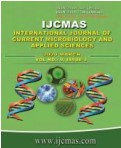


 National Academy of Agricultural Sciences (NAAS)
National Academy of Agricultural Sciences (NAAS)

|
PRINT ISSN : 2319-7692
Online ISSN : 2319-7706 Issues : 12 per year Publisher : Excellent Publishers Email : editorijcmas@gmail.com / submit@ijcmas.com Editor-in-chief: Dr.M.Prakash Index Copernicus ICV 2018: 95.39 NAAS RATING 2020: 5.38 |
A field experiment was conducted during kharif season of 2017 at Dr. Rajendra Prasad Central Agricultural University, Pusa, Samastipur (Bihar) to investigate the “Effect of nutrient and weed management practices on yields and economics of aromatic rice ’’. The experiment was laid out in split-plot design and was replicated thrice. The treatments comprised three nutrient levels viz., N1= 100 % RDF; N2=75 % RDF + FYM 5t/ha; N3=50 % RDF + FYM 10t/ha in main – plot, and six weed management practices viz., W1 = Brown manuring; W2= Bispyribac- sodium @ 25 g/ha PoE; W3= Chlorimuron ethyl + Metsulfuron methyl (Almix) @ 4 g/ha at 20 DAT; W4= Pyrazosulfuron @ 25 g/ha; W5=Weed free; W6= Weedy check in sub-plot. The results revealed that treatment N1 recorded the maximum grain and straw yield and also B: C ratio. Among weed management practices, treatment W5 recorded the maximum yield of rice grain & straw whereas, under weed management practices, the maximum value of net returns and B: C ratio was recorded under W2. However, the maximum gross return was obtained in W5. Thus, it may be concluded that the nutrient level N1 is superior to N2 and N3. Secondly, high cost involved in manual weeding makes herbicidal treatments more viable proposition. The weed management practice W2 is a most effective for transplanted aromatic rice.
 |
 |
 |
 |
 |